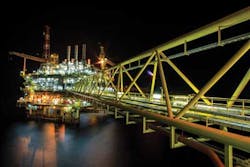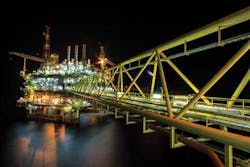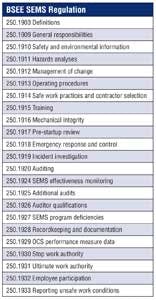Achieving sustainable safety objectives with SEMS
Steve Arendt
ABS Group
James Watson
ABS
Over the years, companies have used a variety of strategies to manage risk – using industry standards, focusing on regulatory compliance, improving performance, and prioritizing accident prevention resources using a risk-based approach. While these efforts have resulted in some improved company performance, progress often is characterized by stops and starts, pauses, regression or plateauing in operations when implementing changes to management systems and operating practices. Today, many companies have adopted an approach of driving "bad things" to zero (e.g., injuries, incidents and spills), which takes the form of using better safety/HSE or process safety measures to minimize potential high-severity consequences, with the ultimate goal of protecting people, assets, and the natural environment.
The goal is admirable and desirable, but there needs to be a much more direct route to achieving safety objectives.
As companies improve the ways they implement management systems – if they encourage safer behaviors and develop a strong safety culture – they are more likely to succeed in achieving sustainable continuous improvement. The fact is that companies that adopt the use of leading indicators tend to do a better job of continuous improvement in process safety. But there are still pitfalls. Only those companies that use leading indicators and strive to understand and nurture a strong safety culture (which helps them achieve better at-risk safety behaviors) can make continuous improvement sustainable for long periods of time.
Class and risk
Proper risk management during the life cycle of an asset underpins the development of class notations. While the notations continue to be applicable, the role of class is changing. Demand for engineering review has grown beyond traditional class services. Today, class societies have to be able to meet the sophisticated needs of a rapidly expanding offshore industry, which includes increased risk and probabilistic analyses of design safety, viability, and practicality.
The move toward risk-based facility inspection programs and more specialized services has led to greater recognition of the contribution a class society can make to facilitate installation safety and integrity. Offshore asset integrity management programs are one example of how structures, equipment, traditional survey regimes, and prescriptive classification rules are being complemented with more proactive risk management processes. This risk-based approach can help offshore operators be better prepared forSEMS (Safety and Environmental Management Systems) compliance as well.
SEMS
For many years, the offshore industry operating on the Outer Continental Shelf (OCS), principally in theGulf of Mexico (GoM), has been driven by standards-based risk management philosophies. In the 1990s, the API created Recommended Practice (RP) 75 - Safety and Environmental Management Programs (SEMP), which was adopted by many major offshore oil and gas companies as a benchmark for offshore HSE management.
From the mid-1990s to 2009, the industry pursued voluntary implementation of SEMP. The former Minerals Management Service (MMS) evaluated 13 years of voluntary SEMS Performance Measures reported by OCS operators and determined that there was a continuing drop-off in performance as measured by enforcement actions, spills, and incidents. So, in 2009, MMS proposed a new regulation to help manage the risk of OCS activities.
MMS evaluated the "implied root causes" of these performance issues and determined the four main areas of weakness were related to the implementation of hazard analysis, management of change (MOC), competency/training, and mechanical integrity. Adding incident investigation and compliance audit requirements, MMS proposed what amounted to an "RP 75-lite" regulation that received large push back from companies working in the GoM.
Following the Macondo incident, the newly established Bureau of Ocean Energy Management, Regulation and Enforcement proposed the SEMS regulation, which incorporated all of RP 75. Companies were given one year to develop compliant SEMS programs and another two years to prepare for the first compliance audit. Mid-way, the Bureau of Safety and Environmental Enforcement (BSEE) proposed a change, called SEMS 2, which included four additional elements and required compliance audits to be led by independent third parties.
Embedded within SEMS is an annual requirement for OCS leaseholders and contractors to submit safety and environment performance data aggregated on a quarterly basis. This has been in effect since March 2011. Gathering performance metrics and associated data for the past three years, BSEE should now have real-world data against which to measure GoM safety performance.
Center for Offshore Safety
One industry reaction to Macondo and the subsequent Presidential Commission report was the establishment of the Center for Offshore Safety (COS) in 2012. Initially focusing on deepwater operators – but now reaching out to all of the OCS operators and contractors – the COS has established a five-year plan of initiatives, several of which already have been completed. The COS also fosters communication of industry effective practices thought its advisories and annual safety forums and the various project work committees.
Following collaboration with other offshore industry groups (e.g., Offshore Operators Committee, IADC, and others) to create SEMS audit checklists and guidance, the COS' first initiative was to establish an independent third-party audit service provider program. In 2012, API accreditedABS Quality Evaluations as its first certificate holder – followed by several additional auditing companies. With the first round of audits now complete, operators, the COS, and BSEE are in the process of executing corrective actions, monitoring progress, and learning from the experience.
As an additional initiative to help industry meet its performance improvement intent/obligation in the SEMS rule, the COS is working with industry groups and government to establish Safety Performance Indicators (SPIs) for offshore drilling, construction projects, and production.
COS member companies are collecting SPI data with the intent of sharing them with the COS so BSEE and the industry as a whole can glean lessons that will help monitor and improve HSE performance on the OCS.
HSE performance
OCS operators are obligated to comply with the SEMS regulation, and as part of meeting that obligation, must address aspects of assessing and improving performance. As a third-party inspector, ABS and its affiliated companies offer some suggestions that can help operators meet their SEMS obligations and improve HSE performance:
- Develop metrics/SPIs to monitor SEMS performance – consider using the COS model
- Consider including/expanding the use of leading indicators beyond those in the COS model to address other important accident prevention barriers (e.g., MOC, Safe Work Practices, etc.)
- Find ways to incorporate lessons from relevant learning sources – incidents, inspections, audits – from other companies and industries
- Establish goals and an accountability approach throughout the operational chain of command
- Develop metrics as part of performance review for SEMS key positions
- Develop a management review element/activity to integrate continuous improvement and to satisfy the annual SEMS performance review requirement
- Consider establishing a way to periodically evaluate and foster safety culture offshore.
If this approach is as successful as anticipated, the offshore industry will see a correlation between the application of safety metrics and improved HSE performance. In the end, this approach will help industry progress toward improving process safety/HSE and, ideally, eliminating major offshore accidents.
Human element in safety management systems
Kevin McSweeney
ABS
Offshore companies, along with maritime entities, are responding to the critical role of the human element as a cornerstone of an effective Safety Management System (SMS). One of the keys to success is achieving a more comprehensive understanding of the human element. Human Factors Engineering (HFE) is a unique and specialized engineering discipline that integrates human behavioral and physical capabilities and limitations with traditional engineering disciplines to produce effective human-system interaction that compliments SMS activities. The goal is to minimize the potential for human error and incidents so personnel can perform assigned activities as efficiently and effectively as possible. Understanding human capabilities and limitations is a primary means of overcoming opportunities for human error.
ABS' Safety & Factors Group is working with Lamar University (Beaumont, Texas) and industry partners on the Mariner Personnel Safety (MPS) project to create a database of global maritime injury and close call reports as well as safety culture assessment results.
These databases are analyzed to identify trends, possible causes, and potential lessons learned/corrective actions and to develop industry benchmarking statistics. In analyzing injuries and close calls, it was apparent that a large number were related to ergonomic or human factors engineering (HFE) deficiencies.
As an extension to these projects, development is underway on an online Maritime Safety Center that will act as a repository for safety-related data based on research efforts involving the MPS project, safety culture, and leading indicators of safety activities. The objective of this safety center is to offer a way of publicly sharing data in a usable context for owners and operators. The data will include maritime industry injury and close call benchmarking and trending metrics, a selected database of industry developed corrective actions and lessons learned, and the combined results of MPS and safety culture data analyses. The center is expected to launch later this year.
Another related project is developing Guidance Notes for the Implementation of HFE into the Design of Offshore Installations. These Guidance Notes offer a strategy for integrating and implementing HFE into the design process as a way to help improve human performance and personnel efficiency and reduce safety risks associated with working and living on offshore installations. The objective is to identify HFE activities that need to be considered to effectively and efficiently integrate HFE into existing project management systems. These Guidance Notes are based on the application of HFE to offshore design and on many years of lessons learned.


